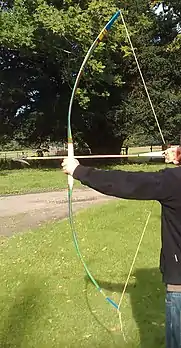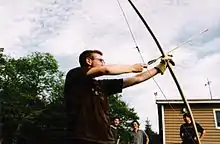Flatbow
A flatbow is a bow with non-recurved, flat, relatively wide limbs that are approximately rectangular in cross-section. Because the limbs are relatively wide, flatbows will usually narrow and become deeper at the handle, with a rounded, non-bending handle for easier grip. This design differs from that of a longbow, which has rounded limbs that are circular or D shaped in cross-section, and is usually widest at the handle. A flatbow can be just as long as a longbow, but can also be very short. Typical lengths would be 68–70 inches (172.5–178 cm) for a flatbow, 70–72 inches (178–183 cm) for an English longbow, and 72–76 inches (183–193 cm) for a warbow-weight English longbow; but these styles may easily overlap each other. Traditional flatbows are usually wooden self bows (bows made of one solid piece of wood), though laminated and composite flatbows have been made in ancient and modern times. Modern flatbows commonly use fiberglass.

Advantages of a rectangular cross-section
The flatbow is a superior bow design for almost all materials because the stress is more evenly spread out than with rounded limb sections. A bow limb is essentially a flexed beam undergoing bending, and in any flexed beam the farther from the neutral axis (line in the middle of the flexing beam which is not under tension or compression: see diagram in Bending article) the more stress there is within the material. When a limb is rounded, as in a longbow, some material sticks out farther from the neutral axis, and thus is put under greater stress. In a flatbow, the flat belly and back ensure that all of the most strained material is a uniform distance from the neutral axis, spreading the load over a wider limb, minimizing stress and making weaker woods far less likely to fail (break or become permanently bent and lose the resilience needed in a bow). Only particularly resilient timbers can make an effective and powerful wooden longbow.
Suitable timbers


In most parts of the world, common hardwoods may be used to create excellent bows. Suitable and easily available timbers include elm (used in ancient Europe, as evidenced by bows pulled from European bogs), maple, sycamore, hazel, and ash. The flatbow design also lends itself to very dense, high strength woods such as hickory and especially osage orange (a wood favored by many Native American tribes for bow making).
Disadvantages of a rectangular cross-section
Compared with a narrow, rounded longbow design, the bowyer needs to start with a wider stave, take more time to achieve an approximately rectangular cross-section, and may need to cut through growth rings on the back of the bow.
Historic use
Flatbows were used by Native American tribes such as the Hupa, Karok, and Wampanoag, prehistoric ancient Europeans, some Inuit tribes, Finnic nations and a number of other pre-gunpowder societies for hunting and warfare because, unlike longbows, good flatbows can be made from a wide variety of timbers. Flatbows fell from favour in Europe after the Mesolithic, replaced with yew longbows. The trade of yew wood for English longbows was such that it depleted the stocks of yew over a huge area.[1] Flatbows are currently used by the Sentinelese tribes of the Andaman Islands. Flatbows survived in cold areas, such as Finland, where yew does not grow naturally because of the unsuitable climate. The traditional Finnish flatbow is made either from ash, or as birch/pine laminate with siyahs made of hagberry and glued together with glue, made by cooking descaled skins of perch with minimum amount of water, until one will get a solution like thick, slimy, grey porridge. This kind of glue will never be all waterproof and the bows were most often wrapped with thin strips of birch bark, protecting them against weather and moisture. Yew was available as an imported material (it grows in Southern Sweden and Denmark and it was even cultivated there) for bows in Finland, but it was considered not suitable for serious use, because it is fragile at cold temperatures and the season for hunting for furs is in January and February, when the furs are at their best.
American longbow

The American longbow, also known as the American semi-longbow (ASL), and sometimes incorrectly called the American flatbow (see above for the correct definition of flatbow), was developed in the 1930s. It resulted from scientific investigation into the best cross-sectional shape for a bow limb. This research was expected to explain why the English longbow's D-section was superior to all other extant designs. Instead, it showed that the best cross-section was a simple rectangle.[2] The American longbow was developed by applying these research findings to the English longbow. The result was a more efficient and stable bow which can be made from more common woods. Because of its coincidental resemblance to some Native American bows, the American longbow was sometimes referred to as the semi-Indian bow, though the Indian bow was generally shorter. The label semi-Indian bow is more in reference to the flatbow,[3] not the longbow.
One of the primary differences between an American longbow and a flatbow - is that the flatbow has wide limbs and a narrow handle section.[4][5] The American longbow has narrow limbs and a handle that is of similar width.
The American longbow was popularised by Howard Hill and quickly displaced the English longbow as the preferred bow for target shooting at the time. Howard himself referred to it as a semi-longbow.[6] It was not long before Howard started to use fiberglass on the back and belly of his bows. Consequently, the ASL is sometimes referred to as a Hill style bow.
The American Longbow is not to be confused with what is now marketed as a modern longbow or hybrid longbow which is just modern marketing pseudo term for what was called a semi-recurve prior to the 90's. IFFA (The International Field Archery Association) does not recognize the modern or hybrid longbow as a longbow,[7] and hence these are shot in recurve divisions.[8]
See also
References
- Yew: A History. Hageneder F. Sutton Publishing, 2007. ISBN 978-0-7509-4597-4
- Hickman, C. N.; Nagler, Forrest; Klopsteg, Paul E. (1947), Archery: The Technical Side. A compilation of scientific and technical articles on theory, construction, use and performance of bows and arrows, reprinted from journals of science and of archery, National Field Archery Association.
- Outdoor Sports publication page 49
- From Popular Mechanics March 1941, page 439
- Outdoor Sports publication page 49
- Hunting the Hard Way by Howard Hill
- The International Field Archery Association Archer's Handbook 7th Edition (2021-2022) page 8
- Page 8 Section J.
- The Traditional Bowyers Bible Volume 1. 1992 The Lyons Press. ISBN 1-58574-085-3
- The Traditional Bowyers Bible Volume 2. 1992 The Lyons Press. ISBN 1-58574-086-1
- The Traditional Bowyers Bible Volume 3. 1994 The Lyons Press. ISBN 1-58574-087-X
- The Traditional Bowyers Bible Volume 4. 2008 The Lyons Press. ISBN 978-0-9645741-6-8
- Gray, David (2002) Bows of the World. The Lyons Press. ISBN 1-58574-478-6
- The Flat Bow by W. Ben Hunt & John J. Metz, 1936.
